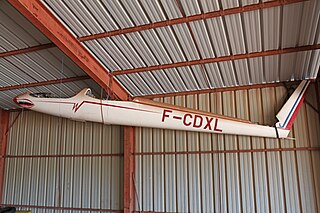
The Schempp-Hirth Discus is a Standard Class glider designed by Schempp-Hirth. It was produced in Germany between 1984 and 1995 but has continued in production in the Czech Republic. It replaced the Standard Cirrus. It was designed by Klaus Holighaus.

The ASK 13 is a two-seater glider that was built by German sailplane manufacturer Alexander Schleicher Gmbh & Co. It was and still is widely used for basic training of glider pilots.

The Schleicher K 8 is a single-seat glider designed by Rudolf Kaiser and built by the Alexander Schleicher company of Germany.

The Schleicher Ka 6 is a single-seat glider designed by Rudolf Kaiser, built by Alexander Schleicher GmbH & Co, Germany and is constructed of Spruce and plywood with fabric covering. The design initially featured a conventional tailplane and elevator which was later replaced by an all-moving tailplane in the -Pe and Ka 6E variants. Variants built before the -CR and -BR used a main skid as the principal undercarriage, with later variants including the Ka 6E using a wheel as the main undercarriage with no nose skid. Other modifications for the Ka 6E include a more aerodynamic fuselage with glassfibre nose and wingroot fairings, longer canopy, and modified aluminium airbrakes.

The Scheibe Bergfalke is a German glider designed by Egon Scheibe as a post-World War II development of the Akaflieg München Mü13 produced before and during the war.

The Scheibe SF 28 Tandem-Falke is a German motorglider that was designed by Egon Scheibe in 1970 and which flew for the first time in May the following year. It was a development of the Scheibe Falke with seating in tandem rather than side-by-side as in the original Falke design.
The LIBIS-17 was a two-seat sailplane for advanced glider training. It was built in Yugoslavia (Slovenia) in the early 1960s and achieved production.

The Scheibe Zugvogel is a West German, high-wing, single-seat, FAI Open Class glider that was produced by Scheibe Flugzeugbau. The first version was designed by Rudolph Kaiser and subsequent versions by Egon Scheibe.

The Scheibe SF-24 Motorspatz is a West German high-wing, single-seat motor glider that was designed by Egon Scheibe and produced by Scheibe Flugzeugbau.
The Bréguet Br 900 Louisette was a short-span, single-seat competition sailplane built in France in the 1940s. It set some French gliding records but was unsuccessful at the international level. Only six production aircraft were built.

The Bréguet Br 905 Fauvette is a single-seat, standard class, competition sailplane, designed and produced in France from the late 1950s. Some 50 were built but most remained grounded after a structural accident in 1969; a few remain airworthy.

The Wassmer WA 26 Squale is a single seat, 15 m (49 ft 3 in) span competition glider, designed and produced in France in the late 1960s. It has wooden wings and a glass fibre fuselage. The Wassmer WA 28 Espadon is an aerodynamically very similar development with a glass fibre wing.
The Kirigamine Mita is a training glider, seating two in tandem, designed in Japan in the early 1960s. A modified version, first flown in 1966, was produced in modest numbers.
The LCF II is a single seat Club Class glider, designed and built in the 1970s by German glider club members and intended to be suitable for training, competition and in particular aerobatics. Only one was completed.
The Scheibe SF-30 Club-Spatz is a 15 m class single seat sailplane built in Germany in the 1970s and intended for club use.
The IIL IS-9 was a low powered, experimental pod and boom style motor glider, designed and built in Romania in the late 1950s.
The IIL IS-11 was an aerobatic, single seat glider, designed and built in Romania in 1959. It was built in small numbers.

The IFIL-Reghin RG-5 Pescăruș or CIL Reghin RG-5 Pescăruș was a Romanian single seat sailplane built in the 1950s. Twenty six were constructed for gliding clubs.
The Merville SM.31 is a French high performance glider with a laminar flow wing, first flown in 1960. Only one was built.
The Scheibe SF 32 is a German motorglider that was designed by Egon Scheibe in the 1970s.











